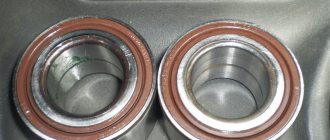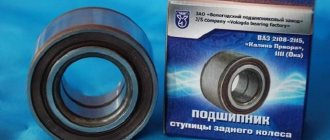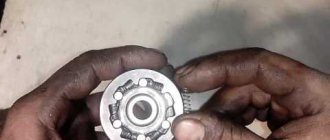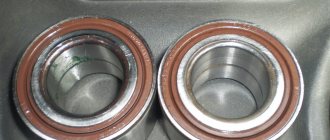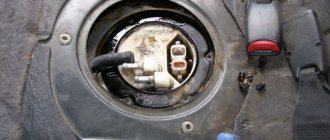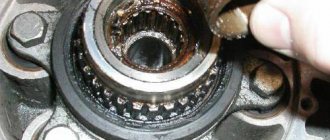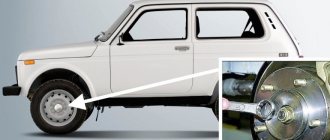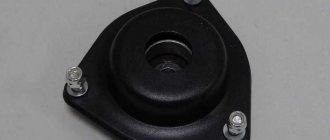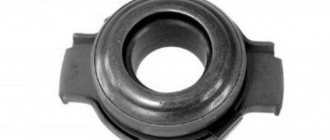Previously, we wrote about the method of selecting a hub with a bearing assembly in this material. Analyzing the recommendations and requests of drivers, Avto.pro came to the conclusion that wheel bearings deserve a separate material. Today we will look into a number of things. Firstly, in the classification of bearings. Secondly, in the methodology for selecting them using standard methods, we will highlight several important points. Thirdly, let’s pay a little attention to the issue of counterfeits. This material will help you understand the structure of hubs, their malfunctions, as well as methods for selecting new parts for repair.
Briefly about wheel hubs
It is not without reason that the hub is called one of the most important elements of the chassis. The hub not only connects the wheels to individual chassis elements, but also ensures their normal rotation. If the hub malfunctions, operating the vehicle becomes extremely unsafe. The part takes on the following tasks:
- Fixing the wheel rim;
- Holding a brake disc or drum;
- Keeping wheel units on the axle shaft;
- Transfer of torque to the wheel with minimal losses.
The hub itself is a hollow metal cylinder with an outer rim with holes for fasteners (bolts or studs) and guide bushings. Inside the hub there is a cavity for installing a wheel bearing. Different models have design features that must be taken into account when choosing spare parts. For example, the hub may have seats for an ABS sensor. This is important: different models (and sometimes different generations of the same model) of cars are equipped with hubs for different sensors. For example, Chevrolet Epica V200-250 - the hubs of the Restyle and Pre-Restyle versions are not interchangeable, since they have some differences in design (presence/absence of a metal ring) and are equipped with different sensors.
There are front and rear hubs. They are further divided into 2 more classes depending on the type of drive and wheels of the car. The latter can be leaders and followers. There are several schemes. First : rear-wheel drive, the driving wheels are the rear ones (usually unsteered). In most cases, the hub is rigidly connected to the rear axle axle shaft. Second : front-wheel drive, rear (unsteered) wheels act as driven wheels. The hub assembly is mounted through a bearing on a pin, which is connected either to the suspension arms or to the axle beam directly. Third : front/all-wheel drive, the front (steered) wheels act as the driving wheels. The installation diagram resembles the second one, but the CV joint is involved in the transmission of torque. Fourth : rear-wheel drive, front (steered) wheels act as driving wheels. There is no CV joint, the hub is mounted on the steering knuckle.
Front wheel hub bearing - what is it?
The front suspension of a car performs a huge number of functions, the main one being to ensure vehicle controllability. For reliability, two bearings are installed between the steering knuckle axis and the hub. They may vary in size, but always have a conical shape.
They are secured to the axle with a thrust washer and a nut. The more you tighten the nut, the tighter the rollers will be pressed. This makes it possible to make very precise adjustments to eliminate backlash.
For the driver, there is one not very convenient factor when operating a car. Due to the lack of standard protection and the possibility of contamination if the integrity of the oil seal is damaged, the wheel hub bearing requires constant attention.
We recommend: Gasoline or diesel. What's better?
Very often, lubricant leaks due to high temperature or is washed out due to frequent interaction of the car with water. Accordingly, road dust and sand get into the hub body. Abrasive debris leads to wear of parts that will have to be replaced.
Bearing device
Wheel bearings are one of the most heavily loaded elements of wheeled vehicles. They perceive the weight of the car, multidirectional loads, impacts, vibrations, etc. But this is still a bearing; its structure can be described in a couple of sentences. The main elements of a wheel bearing include:
- Rolling bodies;
- Separator;
- Outer and inner races (rings).
Everything is simple here: a pair of wheels made of high-strength metal, between which rolling elements are pressed, which are separated from the body by an insulator. Depending on the type and purpose of the bearing, its outer or inner race can rotate. An additional element of the part may be an electronic sensor. Next we classify wheel bearings in more detail and the reader will discover that they may have an additional design element.
Using the rear hubs
The rear hub is easier to operate. Although its design is almost the same as the front one. An exception may be the steering knuckle. The rear hub bearing, which is part of the rear suspension, is threaded onto the half shaft, being installed in the provided landing location. At the same time, the design of the rear wheels may differ from one car to another. Here's what the rear wheel hub might look like:
- if the suspension is dependent, then they are used on rollers or radials with balls;
- if the suspension is independent, then you only need to use conical ones, two on each side.
Since the rear wheel hub cannot be repaired, if the possibility of adjustment for pressing against the holder disappears, then if it is worn, it should be replaced. It is easy to buy, it has a specific serial number, which includes all the information about the individuality of the bearing. You should also buy a rear hub oil seal, which also deteriorates over time. But usually it changes along with replacing the hub.
Four generations of wheel bearings
As the automotive industry developed, wheel bearings were actively refined. At the moment, there are 3 independent generations of bearings: from 1 to 3 (usually designated by Roman numerals I-III). Separately, there is a fourth generation, about which later. In English-language sources, generations are called Hub-I, Hub-II, etc. You may encounter the same designations in Russian-language sources. There may also be explanations like “1st generation”, “2nd generation”, etc. Separately, it is worth highlighting the zero generation of wheel bearings. These are single-row ball, less often tapered roller bearings. Here are the main features of the “current” generations:
- Hub - I. _ Angular contact ball or tapered roller bearing with or without seal. Provides simple preload adjustment, which zero generation bearings cannot boast of;
- Hub - II . A further development of Hub-I, in which the bearing received holes for fasteners on the outer flange. Easy to install, dismantle and center. Compatible with ABS systems. The structure is closed;
- Hub - III . They have a pair of flanges with mounting holes. Even easier to install, dismantle and adjust. For some products, the preload is set at the factory. Integration of modern ABS sensors is extremely simple. The structure is closed.
You can find detailed information about all generations of bearings in the training materials. Good manuals describing each generation and its advantages over previous ones can be found at NTN-SNR. These materials have been translated into Russian. The company is working on a new generation of wheel bearings: Hub-4 (GEN4 H/J). Note that Roman numerals are not usually used in this generation designation. In fact, this is a wheel bearing built into the CV joint.
Most European cars on the roads in Eastern Europe are equipped with Hub -1 . This somewhat simplifies the selection of spare parts for repairs. But more modern models from VAG, PSA and Daimler-Benz are almost entirely equipped with the next generation Hub-II wheel bearings. Some car models have Hub-III - this applies to some Opel, Lancia and others. If it can be difficult to distinguish representatives of the second and third generations by eye, then distinguishing them from the zero and first is very simple - such bearings do not have special holes for fasteners (to put it simply: they do not have a flange).
Adjustable and non-adjustable bearing - what's the difference?
The used car chassis parts have different designs. Their maintenance, replacement and characteristics depend on this.
general information
Wheel bearings vary in type. But they are united by components:
- separating separator;
- rolling bodies;
- clips – internal and external.
The fit of the parts is the same: the outer part is fixed motionless, the inner part transmits rotation.
Adjustable bearing and examples of car brands
The design of these parts is classic - two cages, between which rolling bodies are installed. Some models have a separator-separator. There are two types of such nodes:
Single-row conical, paired (hub unit):
Double-row ball, roller (HUB 1 generation) with separate inner ring:
Peculiarities:
- require scheduled adjustment of free play;
- dry design requires pre-lubrication;
- Only work with insulating seals is allowed.
Setting the amount of radial displacement is done by correctly tightening the wheel bearings.
To study the topic, it is recommended to read the article: Front wheel wheel bearings - what they are and how to replace them.
Usage example:
| Type | Brand | Installation |
| Conical with rollers, single row | VAZ 2101-07 “Classic”, Niva, UAZ Patriot (throughout production) VAZ 2123 Chevrolet Niva VAZ 21214 (after 2004) | Front axle |
| Fiat (old edition) | ||
| Conical double row, roller | DACIA LOGAN (since 2004), MCV (since 2006), SANDERO (2009) | Front axle |
| Ball double row | BMW 2000, 2500, 2800, 3000, 3300, 3 series (1977-1982) | Both |
| Lada Kalina, Priora (two-row, all years) | Front |
Hot topics of the magazine BEHIND THE DRIVE:
Unregulated - description and examples of car brands
Late-year car models are equipped with unregulated systems and, more often than not, not even maintained. The gap between the components is compensated by the preload and tightening torque of the hub nut.
To study the topic, it is recommended to read the article: Front wheel wheel bearings - what they are and how to replace them.
Modifications HUB 2, 3 are combined with a hub base. This solution simplifies operation, but setting the offset is not provided - the entire element must be replaced. Some options have a splined groove for the drive axle.
Unregulated pairs are installed (example):
| Type | Brand | Installation |
| Fixed Ball Double Row | VW Caddy, Eos, Golf, Jetta, Passat, Touran (all years) | Both axes |
| LANCIA Lybra (1998-2005), Musa (2004-2012), Ypsilon (present) | Both axes | |
| SKODA Octavia (all generations) | Both axes | |
| RENAULT Trafic III from 2014 (HUB 4, integrated into the disk) | Front |
This is interesting: Changing engine oil - why and when?
Signs of a bad wheel bearing
Spare parts for Lancia ypsilon
Distilled water
YPSILON I hatchback (843) (10.03 - 12.11)
Spare parts for Chevrolet epica
Motor oil EPICA sedan (V250) (06 - )
Regardless of the design of the hub and the bearings used in it, the entire assembly will be operated under harsh conditions. It is not surprising that over time they will completely fail. The average resource of a good part is 100-120 thousand kilometers. If the operating conditions are not too difficult, then it will be even larger. Here are the main markers of a wheel bearing failure:
- A hum that becomes louder the higher the vehicle speed;
- The appearance of vibrations in the steering wheel and body;
- Crunching sound when driving at any speed.
The third marker indicates critical wear of the bearing - destruction of one of the rings. not recommended to actively operate a car with such wheel bearings . The wheel may jam or fall off the axle. The latter, however, rarely happens, but you should not ignore the problem of bearing wear.
As stated above, the wear rate of a part is determined by operating conditions. When driving on poor-quality roads, frequent impacts and strong vibrations, the rolling parts will wear out faster, and their tracks on the bearing races will also begin to deform. If dust, dirt and sand get inside the part, wear will accelerate many times over. To prevent this from happening, modern bearings are equipped with metal or plastic covers that protect the “filling” of the bearing. Note that the lubricant contained in the sealed bearing is designed for all subsequent operation. The need for maintenance of this part is questionable.
Symptoms of failure
This is where the most interesting thing is - how to determine a malfunction; there are several hundred percent methods.
1) “Dry” crunch . When a wheel bearing fails, a crunching sound appears when driving. These are spherical elements rolling. They broke the clip they were in and are now not evenly distributed. You won’t confuse this sound with anything else; believe me, this sound is perfectly audible in the cabin. This is the very first symptom - as soon as such a sound appears, we immediately go to the service station.
2) Vibration . If the bearing is already well worn, then vibration should appear in both the steering wheel and the body. This suggests that the spherical elements have already worn out the bearing race well, a little more and a “wedge” may occur. We change it urgently.
3) The car is pulled to the side . It is also possible that the part with the faulty element does not work normally - so to speak, it is stuck a little, and therefore the car will pull in one direction or another, as if the wheel alignment .
Part inspection techniques
If you hear a distinct hum when driving, and its source is the wheels, then the wheel bearings should be checked. If the bearings become the source of a “dry” crunch, then their resource is almost exhausted - replace them as soon as possible . But in the first case, the car can still be used. There are several verification methods:
- Jack up the wheels, turn on the engine, gain speed and leave the car in neutral gear. Listen to the wheels running. Humming wheels have faulty bearings;
- Hang each wheel one by one, grab it with your hands and rock it in the horizontal and vertical planes, and then spin it. Severe play will indicate a bearing failure. A more accurate check can be carried out with a partner - he will squeeze the brake when you start to rock the wheel;
- Ask your partner to make a series of very sharp turns at a speed of 15-20 km/h while you listen to the wheels. This way you can determine which side of the car the faulty bearing is on. In the case of double-row bearings, such a check does not always give an accurate result.
A malfunction is also indicated by a number of things that we wrote about in the previous section. In addition to the hum, you should also pay attention to the vibrations of the steering mechanism. If problematic wheel bearings are not replaced for a long time, the driver will face several problems. Firstly, the risk of emergency situations will increase. Secondly, strong vibrations will be transmitted to the body and steering mechanism, which will negatively affect the service life of individual elements of the car. Thirdly, the vehicle's handling . Fourthly, the fuel efficiency of the car will decrease slightly and engine thrust will decrease.
The hub bearing is humming: how long can you drive?
Newbie motorists often ask this question. It must be said that the distance depends on the quality of the roads. In some places, the road surface can easily ruin even the chassis of an SUV. Therefore, once again there is no need to take risks, human life is one.
Professional auto mechanics claim that it is still possible to drive, but this is allowed as long as the hum is still barely audible. Driving is allowed only at low speeds. At the same time, you need to go around small holes and potholes. Even drivers who like to take risks are sure that driving more than 200 km with such symptoms is dangerous. Now you know how to determine which wheel bearing is humming. These tips should help novice motorists who have just gotten behind the wheel of a vehicle.
Methods for choosing a wheel bearing
First, let's look at the classic search methods. They give accurate results both when searching in a store and when shopping on online platforms. The most accurate search is considered to be by VIN code. Since today it is not implemented on all network platforms, we will consider the rest. Namely:
- Search by catalog number. Such numbers can be found on thematic portals, forums, blogs of car enthusiasts, as well as special tables that provide complete information about the products;
- According to the parameters of your car. Namely: make and model, year of manufacture, restyle/pre-restyle (sometimes this is important), engine parameters, etc. Usually the make and model is enough, but there are exceptions. Similarly, it is easy to find spare parts in the general Avto.pro catalog.
Since modern online trading platforms form their own databases of crosses and have special departments dedicated to clarifying the applicability of parts, both methods have the right to life. The method of searching for a wheel bearing by geometry stands out. We do not recommend using this method, as there is a chance of choosing the wrong part. Judge for yourself: a pair of bearings have the same outer and inner diameters (cage parameters), but due to the difference in the angles of inclination of the rolling elements and load capacity, their interchangeability is in question.
If you decide to search by bearing parameters, then study the product that you already have. You need to know its exact geometry. The catalog number will be very useful - it will make it easier to find your specific bearing in the tables. Already during your search, pay attention to the parameters d, D, T, B, as well as the load capacity and chamfer radius. Also take into account the rolling elements, number of rows, bearing type (open, closed), compatibility with the hub with an ABS . If the geometry matches completely or as close as possible, the bearing can be safely ordered and installed on your car. The question of the quality of the selected part remains open. Here it is important to understand the manufacturing companies.
Checking and adjusting the tightening torque
Wheel bearings are tightened strictly according to the factory requirements of a specific car brand. The moment depends on:
- bearing size;
- nominal axial play of the wheel;
- diameter, thread pitch of axle, axle shaft.
To complete the procedure you will need the following tools:
- flat screwdriver;
- chisel;
- hammer;
- pliers;
- torque wrench.
The method for adjusting the hub is practically the same on different cars. Execution order:
- Loosen the bolts.
- Raise the body and remove the wheel.
- Use a flat-head screwdriver to unscrew the protective cap of the hub.
- Unscrew the edge with a chisel. If there is a locking pin, remove it with pliers.
- Check the torque with a set torque wrench. Achieve the required value.
- Reassemble the unit in reverse order and install the wheel.
On some car models, the nut is secured by pressing the edge into the groove. The nut is disposable and must be changed with each adjustment. It is recommended to replace damaged, leaking nut protective caps with new ones.
Example - adjustment on a Chevrolet Niva
It is recommended to perform the procedure on two wheels of one Niva Chevrolet axle.
Structurally, the wheel assembly consists of several parts:
- a steering knuckle held in place by a pair of ball joints;
- brake disk;
- hub assembly;
- support for mounting cylinders, brake pads.
Required set of tools:
Hammer, chisel, flat screwdriver, 27mm socket, dial indicator with tripod.
Step-by-step instructions using the Niva Chevy as an example:
- The car is secured with a parking brake.
- The wheel mounts become loose.
- The body is raised with a jack or lift.
- The protective cap is removed.
- The indicator stand is installed on the hub bolts. Place the leg of the micrometer against the drive axis.
- Measurements are taken.
The presence of a torque that differs from the tolerance indicates the need for adjustment. For this:
- Unscrew the fasteners, unscrew the axle shafts from the thread;
- make a new one;
- tighten to a torque of 19.6-19.7 N*m;
- simultaneously turn the wheel in both directions to self-install the balls;
- Check the condition of the displacement with an indicator and the tightening torque with a torque wrench.
Watch the video for 2 ways to adjust without an indicator:
Example - adjustment on a VAZ 2107
“Classic” VAZ models have a similar adjustment procedure. Design features of chassis parts:
- the hub is located under the brake disc;
- tapered bearings, paired, mounted on a journal;
- different tightening torque.
How to adjust wheel bearings:
Bearing clearance adjustment:
Brand tour
After the driver has selected suitable models of wheel bearings taking into account their applicability, he should pay attention to the manufacturer . Some companies are suppliers to the assembly lines of automakers and offer spare parts to the secondary market that are slightly inferior to the originals. Others offer budget options of poorer quality. And the third is engaged in repackaging the products of the first two. What to choose? To begin with, let's decide on those companies whose products are worthy of the attention of those drivers who expect to receive spare parts of the highest possible quality:
- SNR (France);
- NTN (Japan);
- INA (Germany);
- Toyo (Japan);
- SKF (Sweden);
- Timken (USA).
Packaging companies are second in line. Unfortunately, almost all large packagers today are no longer as selective in choosing suppliers as they used to be. This means that when purchasing their spare parts, the driver can receive either a good quality part or a mediocre one . But the prices will be quite low. It is worth paying attention to Ruville (Germany), (Great Britain), Corteco (Germany).
What can you say about manufacturers of budget wheel bearings? The quality of the products varies from low to average. Drivers should study reviews of such companies in the corresponding section of Avto.pro. Since the hub bearing is a highly loaded part, saving on it is impractical - you can end up spending more on purchasing a new spare part and installing it than if you had originally taken a good Swedish or Japanese product. However, if your budget is limited, take a closer look at the range of packers above. Let us only note that the number of complaints against Corteco is increasing. The company is actively repackaging inexpensive Chinese bearings and passing them off as a premium product.
Is it worth buying the original?
It is often advised to buy original bearings. An original is a part selected by a car manufacturer for sale on markets. These are the parts that are delivered to conveyors. When buying an original bearing, you will be absolutely sure that it will suit you. But there are several questions that need to be addressed here.
The original or a fake?
The original bearings are all the same and if you examine it carefully you will find the engraving. It is located on the edge of the upper or lower part. It should contain several information:
- manufacturer (logo);
- Country of Origin;
- designation digital or alphanumeric details, sizes;
- Additional information is possible;
- The kit must include a hub nut (usually disposable), there may be pins or bolts, seals.
- SKF brand
- Full bearing designation
- Manufacturer country
- Production date code
- Deviation of the average outer diameter ∆Dm [µm] and the position of the maximum eccentricity of the outer ring
- Deviation of the average bore diameter ∆dm [µm] and position of the maximum eccentricity of the inner ring
- Marking of thrust end, stamping
- Serial number (for bearing sets only)
- "V" marking (matched bearing sets only)
If the country of origin is not indicated, it is not an original, but a fake.
Is it worth paying extra for the original?
As a rule, you will find completely similar bearings from different companies on the market. So is it worth paying more for the original if other companies produce the same parts? If you decide to pay attention to any company, then choose well-known, popular manufacturers that supply parts to conveyors. Some people prefer Japanese companies, others prefer European products, for example, they trust only German quality. Our rating of the best manufacturers will help you determine which wheel bearing company is better and who to give preference to. Even if these companies offer products made in China, they will be high-quality products that meet all the requirements. Pay attention not to the country of origin, but rather to the supplier’s brand.
Conclusion
It is quite simple to identify a faulty wheel bearing and replace it using a spare part. The driver can even dismantle the old part and install a new part independently. The secondary market offers spare parts from both large companies and little-known manufacturers. We recommend paying attention to products from well-known companies or buying the original. The problem of counterfeits is acute. Pay attention to the price (it should not be much lower than the market average), packaging, printing, engraving, security features and accessories. The country of manufacture is usually engraved on branded bearings.
Adjustment work
To carry out adjustment work, you will need screwdrivers, a hammer, pliers and a standard set of keys. The adjustment on all cars is virtually identical and differs only in some details.
- On the hub that needs to be adjusted, loosen the wheel bolts.
- Using a jack, lift and remove the wheel.
- Using a hammer and screwdriver, knock off the protective cap mounted in the center of the hub.
- Using pliers, bend the stopper's antennae and pull it out.
- Tighten the hub nut until it stops, then unscrew it back ¼ turn.
- Check that the hub rotates easily. It should spin easily without jamming.
- Put everything back together and check the play again.
If adjustment fails to eliminate play or you notice crunching and jamming during rotation, the bearing must be replaced.
How repairs are carried out
To repair an SNR bearing, it is important to remember not to do this. Since this part cannot be repaired. And it's not about size. She fails completely. Since when removed, all the clinging elements are damaged and cannot be restored. Therefore, as soon as you remove it from its place, you can throw it away. The SNR part is not very expensive, which means that replacing it is affordable for everyone. This is better than losing a wheel on the highway and having to repair not the hub, but the entire car. The cap cannot be repaired either, since it is damaged when removed.
If you decide to replace bearing elements, including caps, then you need to be very careful, as removing them requires a lot of effort. Use only proven methods for removal. In particular, use pressing. Just knocking it out with a crowbar will ruin the seats. Also remember that by removing the nuts and bolts and hubcaps (the hubcaps can still be carefully removed if they are not stuck to the nuts), you will need to replace these parts with new ones.
It is also important to remember that you only need to put back original parts of the same model, for example, SNR. Only in this case will the car continue to function properly. Don't try to find a replacement for SNR. She's gone.
What will happen if you don't change
Many car enthusiasts drive with faulty wheel bearings, and even accelerate at 100 kilometers per hour or more - guys, this is very dangerous, remember this is the connecting element of the wheel, which is responsible for its rotation. If it is broken, it can jam at any moment. And this is a sudden stop of one of the front wheels. Now imagine if your speed is 100 km/h - at that speed you will simply fly off to the side of the road, this is the best case scenario, but you can also fly into oncoming traffic, and then you’re not far from an accident. There have been cases when cars overturned. So guys, the hub bearing is very dangerous, if you don’t want to change it, drive at low speeds, up to 40 km/h, otherwise everything can end very badly.
Diagnostics
Checking the viability of a wheel bearing is quite simple; even a person completely uninitiated in mechanics can do this. On the corresponding side, where suspicious sounds are heard, the front end is jacked up so that the wheel hangs in the air; The disk is held by the top and bottom with your hands and swings: you push with one hand, and pull with the other. If the wheel is freely affected, the bearing is no longer suitable for service. Even at first glance, insignificant play indicates that the bearing has begun to crumble; if the slope is simply dangling, then measures need to be taken urgently.
You can pull and pull with confidence: the wheel can withstand much more serious loads than a person can exert without additional equipment. Summarizing all that has been said, the question of whether it is possible to drive if the hub bearing is humming should be answered this way: it is allowed while the hum is still very quiet, at low speed, avoiding the slightest potholes - and preferably in the direction of a car shop or service station. Even risky drivers believe that it is not worth driving more than 200 km with such symptoms if you value your life and are not ready to live with a heavy burden of guilt for someone else’s
